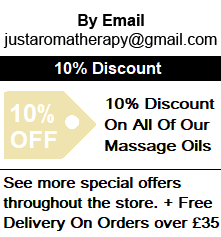Aromatherapy
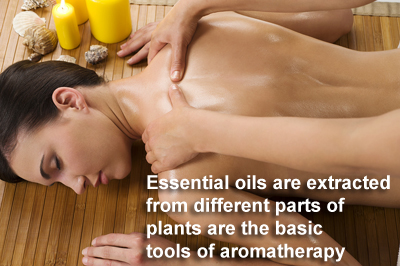
Using Aromatherapy Essential Oils Uses
Discover the fragrant way to look good and feel great using natural oils.
Most of us have heard about aromatherapy. Shelves are bursting with scented beauty products, from face creams to bubble baths and shampoos, claiming to have aromatherapeutic properties. But there is a lot more to it than this. True aromatherapy is actually a complementary medicine that dates back to ancient Egyptian times. But, although this art is enjoying a huge revival, you may not be the wiser about how it actually works and the many ways in which it can help you. Putting yourself in the expert hands of a professional is the ideal(if expensive) way to enjoy the numerous benefits of aromatherapy, but we show you how easy it is to practise this ancient art on yourself.
Discover the fragrant way to look good and feel great using natural oils.
Most of us have heard about aromatherapy. Shelves are bursting with scented beauty products, from face creams to bubble baths and shampoos, claiming to have aromatherapeutic properties. But there is a lot more to it than this. True aromatherapy is actually a complementary medicine that dates back to ancient Egyptian times. But, although this art is enjoying a huge revival, you may not be the wiser about how it actually works and the many ways in which it can help you. Putting yourself in the expert hands of a professional is the ideal(if expensive) way to enjoy the numerous benefits of aromatherapy, but we show you how easy it is to practise this ancient art on yourself.
What exactly is aromatherapy?
It literally means a therapy with aromas. Essential oils which have special aromas and medicinal properties are the basic tools used by aromatherapists. The oils are extracted from various different parts of plants. The bitter orange tree, for example, supplies neroli from the blossom, orange oil from the rind of the fruit, and petitgrain from the leaves of the tree. These essential oils are used in a variety of ways and have a multitude of benefits, not just for physical ailments but for psychological ones too.
Aromatherapy uses essential oils which have special aromas and medicinal properties to treat both physical and psychological ailments. Nerves in your nose are connected to your brain's emotional centre, known as the limbic area. Therefore, different fragrances help to evoke different moods, memories and atmospheres.
Aromatherapy uses essential oils which have special aromas and medicinal properties to treat both physical and psychological ailments. Nerves in your nose are connected to your brain's emotional centre, known as the limbic area. Therefore, different fragrances help to evoke different moods, memories and atmospheres.
How essential oils can help you?
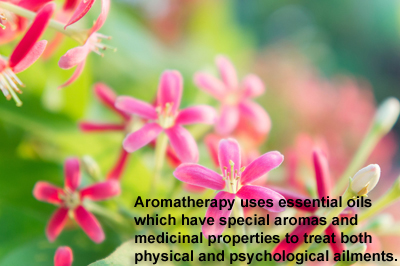
Aromatherapy scores over many other alternative treatments simply because it's such a pleasurable way to deal with ailments and maintain a feeling of well-being. Massaging the body is relaxing and healing, but when essential oils are rubbed into it (always blended with a vegetable carrier oil), they are absorbed into the skin and bloodstream in minuets. In this way, they are transported through the body and, depending on which oils are used, can, for example, sooth the nervous system or stimulate the circulation. It may seem hard to believe, but the fact that some substances including essential oils can pass through the skin is indisputable a number of medicines are now administered in this way. Inhaling vaporised oils also carries them into our bloodstream via the lungs. What's more, the powerful scent of essential oils can alter our mental state because nerves in our nose are connected to the limbic area – the brain's emotional centre. The way we respond to different scents is individual, but there's no doubt that different fragrances help to evoke different moods, memories and atmospheres.
Magic mixes
Essential oils are not oily as you might expect, but mostly have a light consistency. They are highly concentrated and evaporate quickly on contact with air. Some plants yield more oil than others, so prices vary. Rose oil is expensive because it can take 100kg of rose petals to obtain half a litre of oil, whereas 100kg of eucalyptus yields ten litres. Beware of imitations which could just be inexpensive vegetable oils with added synthetic fragrances. It's difficult to prove there purity, but quality essential oils will have safe dropper caps and be clearly labelled. Look for reputable companies that belong to an aromatherapy association or institute, demonstrating that they're responsible and follow a code of ethics.
Pure essential oils are such a complex mix of natural chemical constituents that synthetic copies are not easily made. The unique combinations found in each plant give it its characteristic perfume and therapeutic properties. It is thought that some essential oils complement each others and make an even more potent mix-for example adding lavender to other essential oils increases their activity. Few essential oils are used directly on the skin – there're far too potent. They are generally blended with plant oils that also have therapeutic benefits. Make sure you use pure base oils (look for the term 'cold pressed' which is the best way to extract oils). Don't use mineral oil – it won't absorb easily and doesn't blend well with essential oils. Try grapeseed and soya oils, which are easily absorbed, or wheatgerm oil – it's rich in vitamin E which helps to stabilise the blend so that it lasts longer.
Pure essential oils are such a complex mix of natural chemical constituents that synthetic copies are not easily made. The unique combinations found in each plant give it its characteristic perfume and therapeutic properties. It is thought that some essential oils complement each others and make an even more potent mix-for example adding lavender to other essential oils increases their activity. Few essential oils are used directly on the skin – there're far too potent. They are generally blended with plant oils that also have therapeutic benefits. Make sure you use pure base oils (look for the term 'cold pressed' which is the best way to extract oils). Don't use mineral oil – it won't absorb easily and doesn't blend well with essential oils. Try grapeseed and soya oils, which are easily absorbed, or wheatgerm oil – it's rich in vitamin E which helps to stabilise the blend so that it lasts longer.
Easy applications
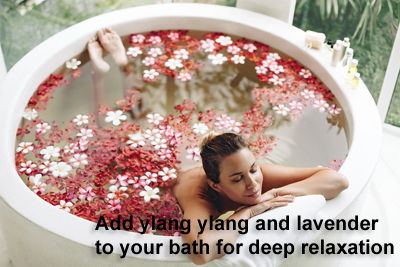
It's so simple to enjoy the healing properties of essential oils.
Massage: This is the main method used by professional aromatherapists but, for the DIY treatment, foot massage is an easy and good alternative – our feet are easy to reach and nerve endings in the soles of our feet are directly related to specific parts of the body. (See our step-by-step massage on the final page of this feature.) You'll also reap benefits by massaging your hands. For a massage, the essential oils used are always diluted with a vegetable carrier oil. It's better to avoid using aromatherapy treatments too soon after exercising because your skin won't be able to absorb the oils properly if you're still perspiring.
Inhalation: Add one to two drops of essential oil to a bowl of hot water and inhale the vapour for about five to ten minutes. Keep your eyes closed. With the right oils, this is a good way to relieve colds, coughs, catarrh and nasal congestion. Alternatively, you can sprinkle a couple of drops of oil on a tissue and inhale.
Compress: Soak a flannel in a bowl containing half a pint of water and two to five drops of essential oil. Wring it out and place on the problem area. Use cold compresses to treat sprains, bruises and headaches. Wrap compresses round an ice cube to make them even cooler. Hot compresses can treat boils and period pains.
Ointments: Antiseptic, pain-relieving and muscle relaxant balms containing essential oils can be found in health food shops.
Baths: Add three to five drops of essential oils to a bath and agitate the water to disperse the oil evenly. Diluting essential oils in a little vegetable oil or mixing them with a cupful of unfragranced shampoo also helps and is better for sensitive skin. Always wipe down your bath afterwards so that it isn't left slippery from the oil.
Room fresheners: The antiseptic and evaporative properties of essential oils make them ideal room fresheners. They can create an atmosphere in a room and treat ills, such as colds, at the same time. Apply a few drops to a tissue on a hot radiator or a small bowl of hot water. Or invest in a aroma stream and vaporising ring, available from us.
Perfumes: Use one or two drops of your favourite essential oil fragrance. Some essential oils, such as strong herb and spice oils and citrus oils, shouldn't be used undiluted on the skin as they cause irritations. Flower oils are the most gentle on your skin.
Massage: This is the main method used by professional aromatherapists but, for the DIY treatment, foot massage is an easy and good alternative – our feet are easy to reach and nerve endings in the soles of our feet are directly related to specific parts of the body. (See our step-by-step massage on the final page of this feature.) You'll also reap benefits by massaging your hands. For a massage, the essential oils used are always diluted with a vegetable carrier oil. It's better to avoid using aromatherapy treatments too soon after exercising because your skin won't be able to absorb the oils properly if you're still perspiring.
Inhalation: Add one to two drops of essential oil to a bowl of hot water and inhale the vapour for about five to ten minutes. Keep your eyes closed. With the right oils, this is a good way to relieve colds, coughs, catarrh and nasal congestion. Alternatively, you can sprinkle a couple of drops of oil on a tissue and inhale.
Compress: Soak a flannel in a bowl containing half a pint of water and two to five drops of essential oil. Wring it out and place on the problem area. Use cold compresses to treat sprains, bruises and headaches. Wrap compresses round an ice cube to make them even cooler. Hot compresses can treat boils and period pains.
Ointments: Antiseptic, pain-relieving and muscle relaxant balms containing essential oils can be found in health food shops.
Baths: Add three to five drops of essential oils to a bath and agitate the water to disperse the oil evenly. Diluting essential oils in a little vegetable oil or mixing them with a cupful of unfragranced shampoo also helps and is better for sensitive skin. Always wipe down your bath afterwards so that it isn't left slippery from the oil.
Room fresheners: The antiseptic and evaporative properties of essential oils make them ideal room fresheners. They can create an atmosphere in a room and treat ills, such as colds, at the same time. Apply a few drops to a tissue on a hot radiator or a small bowl of hot water. Or invest in a aroma stream and vaporising ring, available from us.
Perfumes: Use one or two drops of your favourite essential oil fragrance. Some essential oils, such as strong herb and spice oils and citrus oils, shouldn't be used undiluted on the skin as they cause irritations. Flower oils are the most gentle on your skin.
Aromatherapy - Play it safe
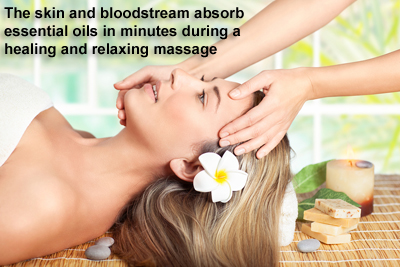
Take great care when using essential oils as they are very potent and can have side effects. Generally, aromatherapy doesn't work well in conjunction with homeopathy. If in doubt about whether aromatherapy is safe for you, check with a practitioner first. Although you may read differently in aromatherapy books, it is always wise to err on the side of caution and follow these simple golden rules:
- Never take essential oils internally. They are only ever for external use.
- If you are pregnant, an asthma sufferer, have blood pressure problems, a long-term illness or epilepsy, it is safest to steer clear of all home aromatherapy treatments.
- Anyone can be allergic to anything and that includes essential oils, so always do a skin test first before treating yourself with a new oil. Dab a little diluted oil on the inside of your elbow, the back of your wrist or under your arm. Leave unwashed for 24 hours and avoid the oil in future if it causes itching, redness or any other type of adverse reaction.
- All citrus oils may leave permanent marks on the skin exposed to strong sunlight.
- When using vaporisers or oil burners, always make sure that you place them where there's no risk of them falling over or setting fire to curtains etc.
- Keep all essential oils out of sight and reach of children and animals. Storing them in a locked cupboard is best.
- Remember when mixing your own oils that you should always stick to the recommended concentration. It doesn't follow that the more you use the better you will feel – in large amounts, some essential oils can be harmful. Six to nine drops per tablespoon of carrier oil is about right.
- Mix oils in small amounts as blends will only last a few weeks. Use glass containers to store your home-made formulas – plastic bottles can degrade when they come into contact with some essential oils.
The skin and bloodstream absorb essental oils in minutes during a healing and relaxing massage.
- Never take essential oils internally. They are only ever for external use.
- If you are pregnant, an asthma sufferer, have blood pressure problems, a long-term illness or epilepsy, it is safest to steer clear of all home aromatherapy treatments.
- Anyone can be allergic to anything and that includes essential oils, so always do a skin test first before treating yourself with a new oil. Dab a little diluted oil on the inside of your elbow, the back of your wrist or under your arm. Leave unwashed for 24 hours and avoid the oil in future if it causes itching, redness or any other type of adverse reaction.
- All citrus oils may leave permanent marks on the skin exposed to strong sunlight.
- When using vaporisers or oil burners, always make sure that you place them where there's no risk of them falling over or setting fire to curtains etc.
- Keep all essential oils out of sight and reach of children and animals. Storing them in a locked cupboard is best.
- Remember when mixing your own oils that you should always stick to the recommended concentration. It doesn't follow that the more you use the better you will feel – in large amounts, some essential oils can be harmful. Six to nine drops per tablespoon of carrier oil is about right.
- Mix oils in small amounts as blends will only last a few weeks. Use glass containers to store your home-made formulas – plastic bottles can degrade when they come into contact with some essential oils.
The skin and bloodstream absorb essental oils in minutes during a healing and relaxing massage.
Care and storage of oils
Essential oils will keep for a year or two if you store them properly. They will keep longer if they are stored in their pure state than if they are mixed with a carrier oil, so try to mix up only a little at a time when you need it. Extremes in temperature and sunlight can spoil essential oils and they evaporate quickly, so it's best to keep them in dark-coloured bottles with their caps screwed on as tightly as you can. Don't leave rubber droppers in the oils they could become corroded.
Our top ten essential oils
Here are the most useful essential oils to have in your home. Remember that you must never exceed the number of recommended drops.
Blue German camomile
Anti-inflammatory and calming. Promotes healing.
- A camomile bath can help aches and pains. Inhaling the vapours may ease hay fever.
-For dry skin: make a mask by mixing ¼ of a ripe avocado with one drop of camomile oil and ½ tsp of fine oatmeal.
- For oily skin: make a mask by mixing a drop of camomile oil, a drop of lavender oil, 1oz fine oatmeal and 1oz ground almonds with a little filtered water. Leave for 5 minutes.
Geranium
Refreshing tonic. It helps to stop bleeding.
- Lymph and circulatory tonic, good for treating cellulite.
- A massage blend is good pick-me-up and also makes an invigorating room freshener.
Lavender
Balancing and healing. Improves the quality of sleep.
- Added to a bath t will help relieve anxiety and exhaustion.
- Used as a compress it will help to soothe the pain of headaches and to heal burns.
Sweet French Marjoram
Sedative with an anti-spasmodic effect on muscles.
- Used as a compress it will help to ease any muscular aches and period pains.
- Added to a bath it will help to relieve insomnia and fatigue.
Rosemary
Stimulating and invigorating to all the body systems. Has a wide variety of applications.
- Add two drops to a final rinse after shampooing to help to alleviate dandruff and make your hair shine.
- Added to a bath it will help to fight fatigue and depression.
Patchouli
Antiseptic. Small quantities uplift, large quantities sedate.
- Use as a treatment for depression by adding to baths and massage blends.
- For spotty skin, try a regular facial massage made using 2tsp of grapeseed oil, one drop of wheatgerm oil and five drops of patchouli oil.
Tea Tree
Powerful disinfectant yet non-irritant on the skin.
- Use for the treatment of acne and boils.
- Inhaling vapours helps to treat colds, coughs, sore throats and other infections.
- For oily and spotty skin, make a mask by mixing 1tsp of brewer's yeast powder with 1tsp of natural live yogurt, 1/2tsp of warm water and a drop of tea tree oil.
Ylang Ylang
A heady, sensual fragrance. Soothes nerves, lifts spirits and is said to have an aphrodisiac effect.
- Add drops to dry tissue and inhale the vapours when you feel anxious, nervy, stressed or depressed.
- Blend in with some lavender oil for a deeply relaxing bath.
Cypress
Astringent and beneficial to the circulation.
- Mix up a massage blend to treat varicose veins and cellilite. Amassage using strokes moving in the direction of the heart will encourage the circulation.
Peppermint
Cooling and reviving; antiseptic.
- Always use in low doses. Never apply directly to the skin and never use in conjunction with homeopathic remedies.
- A compress, inhaling the vapours, a massage blend or three drops added to a bath will help to ease headaches, coughs, colds, flatulent indigestion, aches, nausea, fatigue and some forms of migraine.
If you suffer from either a spotty or oily complexion, giving yourself a regular facial massage using a mixture of grapeseed oil and patchouli oil can be beneficial. An application of neat tea tree oil using a cotton bud is another good treatment for spots or boils, and it's gentle on your skin.
Blue German camomile
Anti-inflammatory and calming. Promotes healing.
- A camomile bath can help aches and pains. Inhaling the vapours may ease hay fever.
-For dry skin: make a mask by mixing ¼ of a ripe avocado with one drop of camomile oil and ½ tsp of fine oatmeal.
- For oily skin: make a mask by mixing a drop of camomile oil, a drop of lavender oil, 1oz fine oatmeal and 1oz ground almonds with a little filtered water. Leave for 5 minutes.
Geranium
Refreshing tonic. It helps to stop bleeding.
- Lymph and circulatory tonic, good for treating cellulite.
- A massage blend is good pick-me-up and also makes an invigorating room freshener.
Lavender
Balancing and healing. Improves the quality of sleep.
- Added to a bath t will help relieve anxiety and exhaustion.
- Used as a compress it will help to soothe the pain of headaches and to heal burns.
Sweet French Marjoram
Sedative with an anti-spasmodic effect on muscles.
- Used as a compress it will help to ease any muscular aches and period pains.
- Added to a bath it will help to relieve insomnia and fatigue.
Rosemary
Stimulating and invigorating to all the body systems. Has a wide variety of applications.
- Add two drops to a final rinse after shampooing to help to alleviate dandruff and make your hair shine.
- Added to a bath it will help to fight fatigue and depression.
Patchouli
Antiseptic. Small quantities uplift, large quantities sedate.
- Use as a treatment for depression by adding to baths and massage blends.
- For spotty skin, try a regular facial massage made using 2tsp of grapeseed oil, one drop of wheatgerm oil and five drops of patchouli oil.
Tea Tree
Powerful disinfectant yet non-irritant on the skin.
- Use for the treatment of acne and boils.
- Inhaling vapours helps to treat colds, coughs, sore throats and other infections.
- For oily and spotty skin, make a mask by mixing 1tsp of brewer's yeast powder with 1tsp of natural live yogurt, 1/2tsp of warm water and a drop of tea tree oil.
Ylang Ylang
A heady, sensual fragrance. Soothes nerves, lifts spirits and is said to have an aphrodisiac effect.
- Add drops to dry tissue and inhale the vapours when you feel anxious, nervy, stressed or depressed.
- Blend in with some lavender oil for a deeply relaxing bath.
Cypress
Astringent and beneficial to the circulation.
- Mix up a massage blend to treat varicose veins and cellilite. Amassage using strokes moving in the direction of the heart will encourage the circulation.
Peppermint
Cooling and reviving; antiseptic.
- Always use in low doses. Never apply directly to the skin and never use in conjunction with homeopathic remedies.
- A compress, inhaling the vapours, a massage blend or three drops added to a bath will help to ease headaches, coughs, colds, flatulent indigestion, aches, nausea, fatigue and some forms of migraine.
If you suffer from either a spotty or oily complexion, giving yourself a regular facial massage using a mixture of grapeseed oil and patchouli oil can be beneficial. An application of neat tea tree oil using a cotton bud is another good treatment for spots or boils, and it's gentle on your skin.
Essential oils for first aid
Try these quick aromatherapy treatments to help sooth minor ailments.
Bruises: Use a cold compress made with three drops of lavender.
Minor burns: Apply ice cold water immediately for ten minutes, than one drop of neat lavender patted on the effected area. Repeat three times daily.
Sunburn: Take a cool and soothing lavender and peppermint bath.
Wounds and cuts: Apply a drop of geranium directly to the affected part.
Toothache: Put one drop of clove oil on a cotton bud and apply to the tooth (don't swallow).
Mouth ulcers and sore gums: Dry the affected area and dab twice a day with either tea tree or myrrh.
Travel sickness: Inhale peppermint or ginger oil from a dry tissue.
Hangover: Inhale the vapours of rosemary, lemon and peppermint oils.
Nasal congestion: Inhale eucalyptus vapours.
Spots and boils: Apply tea tree oil with a cotton bud.
Headaches: Mix a drop of camomile or lavender with a teaspoon of grapeseed oil and use to massage the back of your neck and temples.
PMT: Take a warm bath once a day, adding two drops of geranium, two of lavender and two of clary sage.
Bruises: Use a cold compress made with three drops of lavender.
Minor burns: Apply ice cold water immediately for ten minutes, than one drop of neat lavender patted on the effected area. Repeat three times daily.
Sunburn: Take a cool and soothing lavender and peppermint bath.
Wounds and cuts: Apply a drop of geranium directly to the affected part.
Toothache: Put one drop of clove oil on a cotton bud and apply to the tooth (don't swallow).
Mouth ulcers and sore gums: Dry the affected area and dab twice a day with either tea tree or myrrh.
Travel sickness: Inhale peppermint or ginger oil from a dry tissue.
Hangover: Inhale the vapours of rosemary, lemon and peppermint oils.
Nasal congestion: Inhale eucalyptus vapours.
Spots and boils: Apply tea tree oil with a cotton bud.
Headaches: Mix a drop of camomile or lavender with a teaspoon of grapeseed oil and use to massage the back of your neck and temples.
PMT: Take a warm bath once a day, adding two drops of geranium, two of lavender and two of clary sage.
Step-by-step foot massage
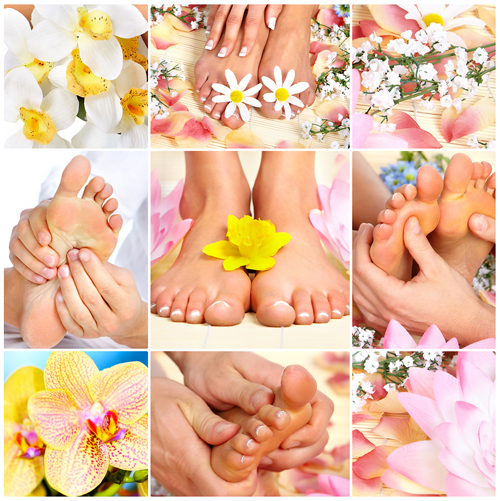
Before you start
Foot massage is as wonderful to give as it is to receive. Use the six easy-to-follow steps below to give a truly professional treatment. It's good idea to relax and cleanse the feet first in warm water. Towel them dry, then lie your partner down with her legs supported on a pillow. Use smooth, gentle hand movements and apply a bit of pressure – this will increase the circulation and also helps to ease tension. Don't be surprised if your partner falls asleep – just congratulate yourself on your new found skills.
1. With the first two fingers of both hands, massage all around the ankle bone using gentle circular movements.
2. Supporting the foot, use your thumb and index finger to stroke down from the top of the foot to the toes three times.
3. With the foot flexed and supported, gently pinch alongside the outer edge from the heel to the little toe.
4. Take each toe in turn and rotate it gently three times in each direction. Use your other hand to stop the foot moving.
5. With the foot flexed and supported, make firm circular movements all over the sole using both your thumbs.
6. Holding the heel in one hand, gently rotate three times in each direction with the other hand.
Foot massage is as wonderful to give as it is to receive. Use the six easy-to-follow steps below to give a truly professional treatment. It's good idea to relax and cleanse the feet first in warm water. Towel them dry, then lie your partner down with her legs supported on a pillow. Use smooth, gentle hand movements and apply a bit of pressure – this will increase the circulation and also helps to ease tension. Don't be surprised if your partner falls asleep – just congratulate yourself on your new found skills.
1. With the first two fingers of both hands, massage all around the ankle bone using gentle circular movements.
2. Supporting the foot, use your thumb and index finger to stroke down from the top of the foot to the toes three times.
3. With the foot flexed and supported, gently pinch alongside the outer edge from the heel to the little toe.
4. Take each toe in turn and rotate it gently three times in each direction. Use your other hand to stop the foot moving.
5. With the foot flexed and supported, make firm circular movements all over the sole using both your thumbs.
6. Holding the heel in one hand, gently rotate three times in each direction with the other hand.



